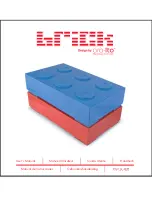
6
Benchtop Router Table Assembly Instructions
Step 4
Position the legs/rails assembly on the bottom face of the router table top
with the Kreg logo facing the front. (The miter-gauge track is at the front
edge of the table top.) Align the holes in the top flanges of the legs with
the pilot holes in the table top. Fasten the legs to the top with eight ¾″
coarse-thread screws
(#17)
. Be careful not to strip out the pilot holes by
over-tightening the screws.
Tighten all sixteen nuts on the leg/rail assembly.
Position the braces
(#7)
on the bottom face of the table top
(#10)
along
the long edges. Align the holes in the braces with the pilot holes in the
table top. Fasten the braces to the top with eight ¾″ coarse-thread
screws
(#17)
.
Step 5
Place the insert plate
(#18)
on your workbench with the target pattern
facing up. Remove the sub-base from your router and select a drill bit
that fits the mounting holes. If your router is equipped with a built-in
lift system, select a bit that fits the lift-access hole. Apply several small
pieces of double-faced tape to the insert plate. Now, center the sub-base
on the plate, using the concentric arcs of the target pattern as guides.
Keep in mind where you want the router controls positioned. Make sure
that none of the holes you are about to drill align with the threaded hole
for the start pin. Press the sub-base firmly onto the insert plate.
Using the holes in the sub-base as guides, drill the holes in the insert
plate with a drill press or hand drill. Performing this operation on a drill
press ensures that the holes are perpendicular to the plate. Before
drilling, securely clamp the insert plate to your drill-press table or bench
to prevent it from moving as you drill. Whether you use a drill press or
hand drill, place a scrap piece of wood under the insert plate to reduce
chipping as the drill bit passes through the plate.
With the holes drilled, remove the sub-base from the insert plate. Flip
the plate over and countersink the mounting holes so the machine screw
heads sit slightly below the plate surface when tightened down. Store the
router sub-base in a convenient place. You will need it when you remove
your router from the router table for handheld routing.
17
7
sub-base
Double-faced tape
18
The included insert plate has center points molded into the bottom
face for drilling mounting holes for the following routers:
Pattern 1
(three holes): Bosch 1617 and 1618; DeWalt 616 and 618; Hitachi
M12VC; Makita 1100; Milwaukee 5616 and 5624; Porter-Cable 690,
890, 7529, 97529, and 8529; and Ridgid 2930 Combo Kit.
Pattern 2
(four holes): Milwaukee 5625-20; Porter-Cable 7518, 7519, 7538, and
7539; and Triton TRA001 and MOF001. Drill holes and counterbores or
countersinks to accommodate the mounting screws supplied with the
router. For routers equipped with a built-in lift system, use the router
sub-base as a guide for the location and size of the access hole and
as a drilling guide.
For routers not covered by
Pattern 1
or
Pattern 2
follow the
instructions
below
.
!
ATTENTION
To view a free video that shows you how to drill your
insert plate, go to www.kregtool.com. You also can have Kreg do the drilling
for a fee. For complete information, go to www.kregtool.com/plateprogram.







































